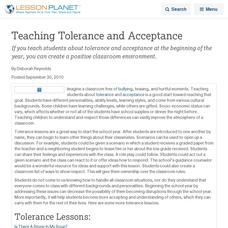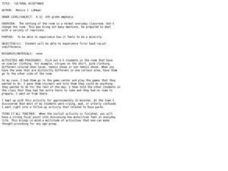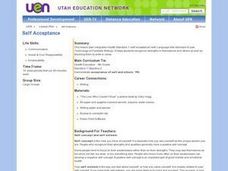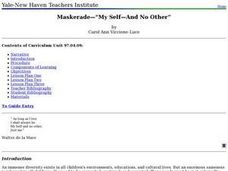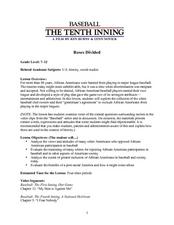Humanities Texas
Primary Source Worksheet: General Washington, Letter Declaring Acceptance of the Command of the Armies of the United States
Discover what influenced president George Washington's decision in his early career to command the United States army by analyzing his formal acceptance with this primary source analysis worksheet.
Curated OER
Teaching Tolerance and Acceptance
If you teach students about tolerance and acceptance at the beginning of the year, you can create a positive classroom environment.
Curated OER
The Crayon Box that Talked: Welcoming Indviduality
Just like a box of crayons, every child has a special way of contributing to the greater picture.
Curated OER
Cultural Acceptance
Students are segregated into groups according to their clothing and experience first hand what it feels like to be a minority in everyday life. For this cultural acceptance lesson plan, students experience discrimination first hand....
Curated OER
How Are We Different?
Students discuss the differences between boys and girls. In this acceptance instructional activity, students view pictures of boys and girls and use a Venn Diagram to chart their differences. Students discuss boy activities...
Curated OER
Making Binding Agreements
Students explore "offer" and "acceptance" in relationship to making binding agreements.
Curated OER
Self-acceptance
Students assess the importance of acceptance of self and others via the development of self-worth and the looking for the good in others not the bad. They explore the task of looking at the world through the eyes of others. In addition,...
Curated OER
Exploring Tolerance and Related Essential Questioning on Acceptance and Diversity
Students explore the concept of diversity. They discuss ways in which people differ. Students visit various websites and discuss the vocabulary words found on these sites. They read stories from various countries and discuss the people...
Learning for Life
Race, Religion, and Culture
Accepting others as individuals regardless of differences in appearances, languages, and interests is an important life skill for youngsters to acquire. The activities provided in this resource will support learners as they explore the...
Curated OER
The Rigors of Learning a New Language
Young scholars read an autobiography of a peace corps volunteer studying Chinese. In this cultural acceptance lesson, students compare the dialects of Chinese with English dialects. Young scholars discuss the differences in learning and...
National Endowment for the Humanities
García Márquez’s Nobel Prize Speech: “The Solitude of Latin America”
To conclude a study of One Hundred Years of Solitude, class members analyze Gabriel Garcia Marquez's Nobel Prize in Literature acceptance speech. After a whole-class discussion of the main ideas in the speech, individuals draft a...
Curated OER
No Name Calling
Students use literacy skills to gain information about tolerance. In these lessons on acceptance, student read stories, answer questions, survey students, and plan a citizenship week to encourage participation in a No Name Calling week.
Curated OER
My List of Acceptance
In this self-assessment worksheet, middle schoolers recount their 10 most memorable and positive experiences of acceptance. An example is provided.
Peace Corps
Brief Encounters
How are Pandyas different than Chispas? Explore cultural norms and societal behaviors with an engaging role-play activity. Split into groups of two hypothetical cultural groups, the formal Pandyas and the sociable Chispas, and another...
Curated OER
October: Respect for Self and Others
Students realize their worth and dignity as human beings and account for their strengths as well as display their weaknesses. They display good manners and politeness, showing the respect for others as they would wish for themselves....
Curated OER
CULTURAL ACCEPTANCE
Learners witness first hand what it feels like to be discriminated against.
Curated OER
Maskerade, My Self, And No Other
Students examine themselves, discover their strong, positive attributes, and recognize areas in need of improvement (since each individual possesses strengths but all people have some weaknesses). They develop self-acceptance, trust in...
Curated OER
Have Minorities Gained Acceptance
Learners cite evidence gathered from magazines about how much Blacks are accepted into the mainstream of American life. They support their conclusions by writing an answer to an essay question.
PBS
Baseball: The Tenth Inning - Bases Divided
Baseball is a relatively high-interest topic through which social studies classes can explore racial prejudice in the US. Video clips provide much of the background information that groups record on their handout and then share with the...
Curated OER
Acceptance Through Patchwork
Students are asked to look at differences in people and accept those differences but to examine that people are more alike than different. The lesson has the central focus of investigating diversity.
Curated OER
Navajo Pottery: Beautiful Objects
Young potters make their very own version of the classic Navajo Pottery. With helpful worksheets and applicable cross-curricular activities, the instructional activity is an enriching way to mold both your clay and the...
Curated OER
Let There Be Peace: Nobel Prize Winners
What is the Nobel Peace Prize? After they establish criteria for great leadership, secondary learners read a New York Times article about President Jimmy Carter's acceptance of the Nobel Peace Prize in 2002. Individuals research the...
PBS
Stereotypes vs. Statistics (Grades 4-8)
Stereotypes can be painful if they are used to discriminate against others. Statistics, however, can be helpful in dispelling myths propagated by stereotypes. Using a thoughtful lesson plan, scholars complete graphic organizers...
Curated OER
Outsourcing Jobs to Other Countries: Is Globalization a Threat to American Workers?
Students analyze the effects of outsourcing. In this globalization instructional activity, students listen to their instructor present a lecture regarding the outsourcing of American jobs to other countries. Students respond to...

